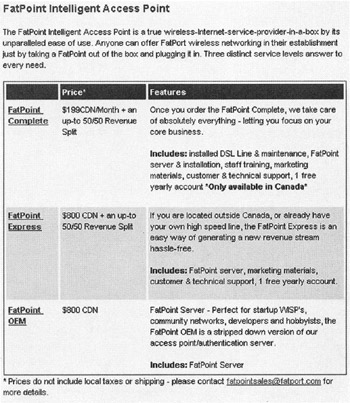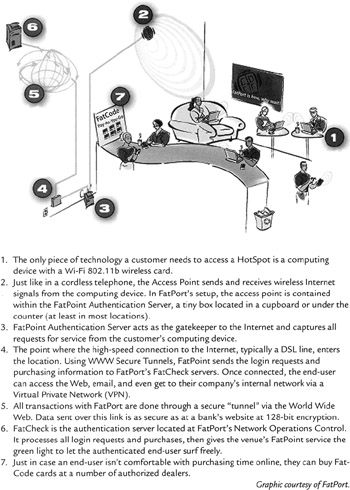Chapter 12: Building a Hotspot
|
| < Day Day Up > |
|
As the reader should now understand, it is possible for established businesses to create additional revenue streams and for entrepreneurs to build a HotSpot without a large capital outlay for expensive, complex network hardware. The previous chapter discussed the "run of the mill" hardware necessary for the proper deployment of a small HotSpot. Turnkey solutions, however, provide an even easier method for HotSpot operators to deploy Wi-Fi service. That's because most HotSpot-related solutions provide an integrated group of functions and features, e.g. billing, security, and roaming and the provider offers them on a resale or revenue-sharing basis. Most offer the HotSpot operator (a/k/a "the reseller") a very attractive proposition-10 to 40 percent margins depending on the location and the reseller's sales and marketing efforts. Public access rates vary, but are beginning to settle to around $10 per day, depending on the venue's property type and geographic location,
Hotspot Kits
These solutions are dubbed "turnkey" or "HotSpot" kits and are increasingly available throughout the WISP marketplace. The kits provide a Wi-Fi access platform, as opposed to a Wi-Fi access point. These smart platforms deliver the fundamental services layer by providing standards-based services such as secure authentication, automated configuration, IP routing, firewalls, caching, remote management, usage tracking, and bandwidth shaping. Each kit requires only that the venue owner install the software, type in a little configuration information, and voila, a HotSpot is born.
Most of these kits offer the same basic benefits: a quick and inexpensive HotSpot setup; some type of revenue sharing plan; access to other network points (the kit provider's and perhaps its affiliates); software that, in most cases, solves many of the internal network security and management issues (but a closer look at the specific software is warranted); and back-end services such as AAA and customer support. But beware, some kits also may provide unexpected drawbacks, such as including the provider's brand on the end-user's start-up page rather than the brand of the operator or venue owner.
This section reviews some of the features and functionalities to look for when investigating the feasibility of installing a HotSpot using a turnkey kit. With most of the methods outlined herein, all that is needed is a broadband connection with a static IP address, a Wi-Fi-ready computer (PC or laptop), and the turnkey kit. A static address is a permanent IP address for which the ISP usually charges an additional fee-otherwise the ISP assigns a dynamic IP address that changes every time an end-user logs onto the service.
FatPort. This Canadian company has an interesting approach to deploying HotSpots. FatPort has named its turnkey solution, the "FatPoint," which is an all-in-one device that allows a new HotSpot operator to be up and running in a matter of minutes. The turnkey solution includes a FatPoint Server (an NS-GX which is i386-compatible 300MHz CPU with 128MB RAM and a 200mw Wi-Fi card with removable diversity antennae), marketing materials, and customer and technical support. FatPort utilizes the most secure encryption available to ensure end-users' personal data is protected. According to the company, the FatPoint solution also provides a network that is "as secure as online banking, so they can access their corporate networks from your business location, worry-free." The customer purchases time online or uses FatCodes (prepaid calling cards) sold at authorized dealers. FatCodes come in 15-minute, 60-minute, daily, and monthly increments. See Figs. 12.1 and 12.2 for more details.

Figure 12.1: FatPoint allows a HotSpot operator to design a custom login screen that enables the venue or operator to brand the first screen subscribers see with news, special offers and up-and-coming events. Graphic Courtesy of FatPort.

Figure 12.2
Airpath Wireless. This provider offers what it calls an "Instant Hot Spot Provider" service. If a HotSpot operator is interested in a kit that allows it to "fly" its own brand, this service just may be the ticket. Airpath makes it very simple to provision a venue with wireless Internet access. The Airpath kit takes care of the hardware and software, letting the HotSpot operator focus on the front-end activities that are necessary for a successful business (e.g. adding new locations and building a subscriber base) without the capital outlay that normally would be necessary for servers, software, and other expensive network operations equipment. Airpath also takes care of the back-office details such as billing, subscriber management, network management, and customer care.
With the Instant Hot Spot Provider service, the HotSpot operator:
-
Uses its own brand.
-
Owns 100% of the revenue so it can create its own service pricing and policies.
-
Can take advantage of free advertising links (ads, monthly specials, etc.).
-
Owns the end-user.
-
Controls its venues.
-
Has immediate access to all of the benefits of the "AirPath Provider Alliance."
All the installer needs is the skill to use a simple web interface, since that is where the branding, service pricing, and policies are handled. This same web interface is also the management portal into all of the back-office processing, such as authentication, accounting, subscriber management, network management, roaming settlement, customer care, and more. The web interface, for example, provides the HotSpot operator with immediate access to AirPath's "Hot Spot Billing Suite," which is where the operator can choose its service pricing, and branding, and manage its accounts (both the venues and end-users).
Once everything is in place, new end-users can signup for access using the prices the HotSpot operator chooses (not what the service provider dictates), and later these same users will receive email branded account statements and usage summaries.
AirPath even provides real-time credit card processing using its own merchant account; downloadable template marketing materials that the HotSpot operator can customize with its own logo; dynamic reporting that gives the HotSpot operator immediate access to locations, roaming revenue, and more; and dynamic usage reporting that provides the operator with immediate access to end-user and location usage. Finally, the HotSpot operator can choose to support its end-users in-house, or optionally, AirPath will provide customer support.
Note, however, that AirPath's method isn't as simple as some others, such as Fat-Point's or Boingo's, since the company doesn't offer a "one size fits all" approach for HotSpot deployment. This translates into "the potential operator must know enough technology to choose the HotSpot equipment that best meets his or her needs," although AirPath's staff will provide some advice. (The most popular HotSpot equipment such as gateways and bridges are listed on Airpath's website.) And since Airpath doesn't provide the equipment, its back-office systems are based on open standards, i.e. its systems work with all types of equipment and software.
Given that Airpath doesn't provide hardware, its annual services fees are minimal. AirPath charges a flat-rate per-location fee and a flat-rate per unique end-user login in a month. For example, unique end-user Janrey logs into the HotSpot's network two times for which Airpath charges the HotSpot provider a flat-rate fee of $5.00. But when another unique end-user, Texgal, logs on 20 times during that same month, the HotSpot still pays only a $5.00 fee to Airpath, even though the end-user accessed the network much more often. Furthermore, the company doesn't force revenue-shares and doesn't have minimums.
Pronto Networks. This developer of wireless infrastructure solutions provides three distinct ways for a HotSpot operator to set up individual HotSpots and to run its network.
One way is to use Pronto's "Hotspot Networking System." This solution allows HotSpot operators to establish and expand their network without expending a great amount of cash. That's because Pronto's Hotspot Networking System offers both the end-to-end infrastructure solution that enables the HotSpot itself, and the private-labeled, back-office operations for HotSpot operators that prefer to focus on front-end activities.
This system also provides HotSpot operators with all that is required to set up and manage a network of HotSpots (minus the pipe to the Internet). Pronto's complete plug-n-play system incorporates advanced authentication, authorization, billing, security, and roaming features, as well as several features that enable the generation of new revenue, such as location-based and personalized announcements and services.
The next method is what Pronto calls its "Networks Hotspot Managed Services." This solution provides complete infrastructure management services for HotSpot operators. When a HotSpot operator uses this solution, Pronto handles all deployment and provisioning of the venue location using the aforementioned Hotspot Networking System. Then Pronto's Networks Hotspot Managed Services provides all operational aspects of the HotSpot, including initial deployment and installation, network policy design and implementation, and ongoing network management. Pronto also manages the health and performance of the HotSpot operator's network, and provides extensive reporting capabilities. A HotSpot operator that goes with the Networks Hotspot Managed Services plan will incur little upfront capital expenditures since the plan requires only a minimal setup fee per venue, plus a minimal per user fee over time.
Furthermore, since Pronto's pricing model is largely based on the number of end-users, with the HotSpot operator paying in proportion to the revenue their network generates, the HotSpot operator can control its operating costs.
Pronto hasn't left out the "build-it-yourself" operator. For those who prefer to roll their own infrastructure, Pronto offers the Pronto Gateway and Server Software. Pronto's equipment provides an operator with the necessary infrastructure to build and support a network. The equipment solution can be configured to meet any client's specifications.
Boingo Networks is not only targeting individual HotSpot venues, it is also doing its best to make it easy for a business to join the HotSpot operators club. Not only does it provide all of the traditional services of an aggregator (billing, customer service, marketing, etc.), but it also offers a product that it calls a "WISP in a Box." Of course, the product is in essence the Pronto "Hotspot Managed Services" re-labeled. Nonetheless, in an industry where scale is important, through this innovative approach of enabling HotSpot operators to have their own network using Boingo's underlying infrastructure, Boingo can more quickly grow its own network. And, of course, it provides an additional and compelling reason for a budding HotSpot operator to align itself with this innovative aggregator.
| Note | In mid 2002, Pronto Networks and iPass announced two strategic agreements. One agreement allows for iPass users to seamlessly roam onto Pronto-operated WiFi networks, while the second agreement is a technology alliance whereby Pronto's Hotspot Networking System can be offered as a iPass-compliant solution. |
Toshiba/Accenture. The recently formed Toshiba/Accenture alliance hopes to capitalize on the surge in demand for fast on-the-go Internet access. Toshiba's Computer Systems Group technology services company and Accenture have joined forces. The two companies announced in March 2003 that they plan to have around 10,000 HotSpots up and running all across North America by the end of 2003.
The Toshiba/Accenture joint venture offers a turnkey solution for HotSpot operators, which includes hardware provided by Toshiba, and business and operational support from Accenture (e.g. network operations, billing and settlements processing, and help desk support). The kit costs about $200 and enables HotSpot operators to sell HotSpots to venue owners, and then set the product up for them.
As far as compensation is concerned, it has been left to the HotSpot operator to determine the cost of the service to its end-users. The resulting revenue will be split as follows: SO percent of all earned revenue going to the Toshiba/Accenture venture, 30 percent to the HotSpot operator that installs the kit, and the remaining 20 percent to the venue owner. The new venture made no mention regarding who would bear the cost of the high-speed Internet connection.
|
| < Day Day Up > |
|
EAN: 2147483647
Pages: 273